Friends of the Arboretum Newsletter
Fall 2007 – Volume 11, Number 2
 |
 |
 |
 |
Words from the Director
Director's Letter
By Denny Werner, Ph.D., Director
Welcome from the JC Raulston Arboretum. I am writing this message content in the knowledge that, for the first time since I assumed the position of director, the JCRA is fully staffed. Mark Weathington, our new assistant director, joined us on July 23, and he has "hit the ground running." Mark's knowledge of plants is remarkable, and his passion for the JCRA and its collections is infectious. All of us on the staff look forward to his future contributions to the gardens and programs. One of Mark's first initiatives upon arriving was to resume the monthly Plantsmen's Tours, historically a popular program at the JCRA. Look for the dates and topics for these tours in the enclosed schedule of programs. One of Mark's major responsibilities at the JCRA will be plant acquisitions and collections management, and fulfilling the important role of liaison to the nursery industry. Mark will also be taking a lead responsibility in validating the current Arboretum holdings and future accessions for identity accuracy, and coordinating our student intern program. Please welcome Mark to the JCRA family.
I regret to report that Frankie Fanelli, our volunteer coordinator at the JCRA since 2001, has left the JCRA for a community college teaching position. I have known Frankie since she came to NC State University as an undergraduate student in the Department of Horticultural Science in fall 1997. She earned her B.S. in horticulture in spring 2000, and subsequently pursued a graduate degree in horticultural science, which she earned in December 2004. Even during her undergraduate program, Frankie demonstrated a love and passion for the JCRA, which eventually led her to assume the position of volunteer coordinator in 2001. During these past six years, Frankie has worked tirelessly on behalf of the JCRA, and under her leadership, volunteer service has risen to over 9,000 hours annually at the JCRA. All of us on the staff of the JCRA will miss her friendship, her smile, and her passion. Frankie, thank you for all you have contributed. We wish you the best.
 I am pleased to announce that Barbara Kennedy assumed the position of JCRA volunteer coordinator effective July 30, 2007. Barbara has been a volunteer at the JCRA since 2001, and has assumed many roles in her volunteer services over the years, including tour guide and leader of the Tuesday morning roving gardening group. She earned a degree in horticulture from NC State University in 2003. She also has a B.S. in business education from the College of New Jersey, and a M.S. in business from the Georgia Institute of Technology. Barbara currently resides in Raleigh. Please welcome Barbara to the JCRA staff.
I am pleased to announce that Barbara Kennedy assumed the position of JCRA volunteer coordinator effective July 30, 2007. Barbara has been a volunteer at the JCRA since 2001, and has assumed many roles in her volunteer services over the years, including tour guide and leader of the Tuesday morning roving gardening group. She earned a degree in horticulture from NC State University in 2003. She also has a B.S. in business education from the College of New Jersey, and a M.S. in business from the Georgia Institute of Technology. Barbara currently resides in Raleigh. Please welcome Barbara to the JCRA staff.
In early June, I had the wonderful opportunity to visit Japan for 12 days,
visiting nurseries and nurserymen, and speaking at the meeting of the Japanese
Nursery Association. This was my first opportunity to visit Japan, or for
that matter, any Asian country. It was a totally rewarding and educational
experience to appreciate the people, food, culture, geography, history, and
horticulture of this beautiful country. I traveled with Ted Stephens of
Nurseries Caroliniana of North Augusta, South Carolina, and Fred Hooks and Ozzie
Johnson of Atlanta, Georgia. All three of them had traveled to Japan
previously, and with the assistance of our wonderful Japanese hosts, arranged
for an incredible schedule of garden and nursery visits. It took some adjusting
for this native southern Pennsylvania boy, raised on Pennsylvania Dutch meals
generally consisting of meat, potatoes, and a vegetable, to get used to the
cuisine. Our first meal upon arrival consisted of raw octopus, squid, and
eel, and the "going-away" barbeque event provided by our Japanese
hosts featured – you guessed it – barbecued octopus. Most importantly, I was
able to bring back some great new plants for the JCRA, including interesting
candidates of Viburnum, Enkianthus, and Parthenocissus.
I will make a presentation of this trip to the membership in the future. I
also want to acknowledge the Japanese Nursery Association for their generous
financial contribution to the JCRA, presented after my talk to that organization.
Their kindness and support is sincerely appreciated.
We are all excited about the completion of the new JCRA Grass-roots Master Plan. The final plan was presented to and approved by the Board of Advisors in April, and presented to the membership at a Friends of the Arboretum Lecture in late June. The completed master plan incorporates plans for the newly acquired acreage adjacent to the existing Arboretum grounds. The plan addresses issues and concerns related to our path system, accessibility issues, equipment access into the grounds, educational programming in the Arboretum, interpretation of the collections, opportunities for student and industry involvement in the Arboretum, and enhancing the presentation of our diverse and eclectic plant collection. Foremost during the development of the master plan was ensuring that the plan was consistent with the JCRA mission statement, and that as always, "It's All About the Plants." Execution of the plan will be a long-term venture, but we can now proceed with development of the Arboretum in a planned fashion. I again extend my sincere thanks to the wonderful group of talented JCRA members who comprised the Grass-roots Master Plan committee: Harriet Bellerjeau, Suzanne Edney, Jeff Evans, Robert Mackintosh, Rick Boggs, Beth Jimenez, and Matt Roberts.
Most of you are aware that we have increased our individual and family membership rates by $10.00. Our Individual membership rate had been maintained at $30.00 for so many years that we have no formal records of when it last increased. I'll spare you the song and dance about why we made these changes, except to say they were necessary to ensure the current financial stability of the JCRA and build some long-term equity for the future. I feel our membership fee is reasonable considering the member benefits, including our discounts at many nurseries, free admission to our FOA Lectures, newsletters, reduced rates for workshops and symposia, our free plant distribution, and the satisfaction of knowing that you are supporting an organization that touches and enhances the lives of so many people. Thank you for your understanding and support in this regard. Along these lines, members who live some distance from the JCRA, and who are unable to regularly attend our FOA Lectures, may ask what direct benefits they derive from membership. I have given this much thought, and asked myself what we can do to enhance value for such members. One initiative that we will institute beginning fall 2007 is to tape all FOA Lectures (pending permission of the presenter) and make them available on our Web site to members only, making them accessible to all members, regardless of distance from the JCRA. We have a great line-up of FOA Lectures scheduled for fall 2007 and spring 2008. I hope to see you at these events, and remember, for those of you who miss a particular lecture, they will be available to members only on the Web site.
Our plant breeding efforts at the JCRA continue to progress. This year's Easter freeze was devastating to the new redbud crosses we attempted, but we have been able to make final selections in various families derived from crosses made in prior years. Selections with weeping architecture and demonstrating variegated leaves or purple leaves have been identified. These will be propagated to facilitate further testing, but we are confident these plants have great commercial potential.
As I prepare this piece on a late July evening, we are in the throes of a serious drought statewide, and the City of Raleigh recently enacted permanent, year-round, pre-emptive watering restrictions. Actually, in my mind, these restrictions are an excellent idea, for they will cause us all to think twice before turning on the tap to water the lawn and landscape. Like those of you who understand that all natural resources are limited, and that as a society we too often take for granted these precious resources, I believe we are fast approaching the day of reckoning as regards our water resources. Officials predict that the population of the state will double within the next 20 to 25 years. Such a dramatic increase will necessitate painful but necessary decisions about how we all use water and other limited resources. The nursery industry has been preparing for this day of reckoning for some time through measures aimed at reducing water usage and capturing water runoff from production areas. Homeowners will need to adapt to the changing reality by adopting measures to reduce water usage, capturing water on site, and growing drought tolerant plants. In the near future, we may reflect with a measure of disbelief that we actually irrigated fescue turf using pop-up sprinklers controlled by automatic irrigation controllers. At the JCRA, we have recently installed some new garden areas that are consistent with the theme of frugal use of water and the use of drought tolerant plants. On the west side of the Ruby C. McSwain Education Center, our Scree Garden is developing into a beautiful garden setting. Comprised of a diversity of drought tolerant taxa from all parts of the world (no, natives are not necessarily more drought tolerant), this garden is thriving in the summer heat and drought conditions; it has not been watered once during the entire growing season. The newly renovated rooftop gardens have been enhanced by removing a significant amount of the uninspiring sedum, and replacing it with a host of plants presumed to be adaptable to this harsh environment. Lastly, continuing on the drought tolerant theme, we have made excellent progress in the installation of the new Geophyte Border adjacent to the rooftop gardens. Over 80% of the species and cultivars intended for this border have been installed, and the planting is looking great. This garden was designed by past JCRA staff member and volunteer Doug Ruhren. Thanks to Doug for his efforts with this border. As you walk these new garden areas and other parts of the Arboretum, please be on the lookout for the new interpretative signs that have been strategically placed to interpret individual plants and collections. Staff member Nancy Doubrava and Erin Possiel, a graduate student in the Department of Horticultural Science, have teamed up to develop these informative educational messages.
The issue of rising atmospheric carbon dioxide levels will be a major challenge to all societies and gardeners in the coming years. The sobering statistics reveal the true nature of the challenge. Global CO2 levels rose nearly 3% in the past year (2006) alone, an incredible increase for such a short time period. At the anticipated rate of future increase, atmospheric CO2 levels by year 2050 are predicted to be about twice that of the levels prior to the industrial revolution. We are entering uncharted biological territory, as the chronic impact of such elevated levels of CO2 on plant growth are largely unknown. Duke University is conducting studies in this area, but so much more is to be learned. Already, I have seen the statements from the uninformed stating that non-natives will be favored over natives as CO2 levels rise and global warming occurs. Well, interestingly, a not-so "warm and fuzzy" native, our own North American poison ivy, has been reported to respond in a dramatically positive way to elevated CO2, both in terms of growth rate and increases of the toxic allergen. The double whammy of increased atmospheric CO2 and global warming will have a dramatic impact on the composition and distribution of plant communities in the future. This, coupled with man's rampant development of our open space, represents in my mind a much greater threat to our native plant communities than does the introduction of non-native ornamental species. As man continues to impact our environment to such an incredible extent, quite frankly, the controversy of native versus exotic plants in landscapes may become a moot point, as the consequences of development and environmental change will far more negatively outweigh the consequences of introducing a non-native species into North America. When the climate of piedmont North Carolina 90 years hence is similar to the climate currently found in central Florida (predicted by some models developed at Duke University), does it really matter if one is growing a native or non-native plant in their landscape? In my opinion, the concept of nativity becomes more nebulous as plant community transitions occur in such a short time frame.
I hope your plants survived the unusually severe freeze experienced during the Easter weekend this past April. In spite of the fact that so many plants were totally fried (is that a horticultural term?) during this event, I was amazed in most cases at how well plants recovered the freeze. As Doug Ruhren once said in a talk, "All plants want to live, except hybrid tea roses." After the loss of growth that was derived from the terminal meristems and primary axillary buds, most species recovered within four to six weeks by reinitiating growth from secondary and tertiary lateral buds, and/or adventitious bud formation. And no, natives did not fare better during the freeze as compared to non-natives, as some trumpeted after the event. Those who stated such must not have looked at Cercis canadensis, Chionanthus virginicus, Cornus florida, and other natives that were temporarily disfigured by the freeze, while some non-natives such as Cornus mas fared very well. Again, broad generalizations about the relative performance of natives versus non-natives hold about as much water as a kitchen sieve. Response to a biological stress such as a freeze event is not a function of nativity status; it's totally a function of the inherent biology of the organism, regardless of its nativity.
I just returned from a 2008 JCRA symposium meeting at Plant Delights Nursery. During this visit, I saw Musa 'Siam Ruby', the new ornamental banana that Tony Avent has planted in front of his shipping facility. What a spectacular plant! Speaking of the JCRA 2008 symposium, please mark the dates of September 26, 27, and 28 on your calendars. We already have some great speakers lined up for this event. It will be a great opportunity for you to listen to and meet these speakers, and also visit with a diverse group of plant enthusiasts from around the country.
As always, the entire JCRA staff thanks you for your support of the Arboretum, through your membership, participation in our programs, gifts-in-kind, financial contributions, and volunteer service. We are so fortunate to have the support of each of you. See you at the JCRA.
Werner's Wanderings
By Denny Werner, Ph.D., Director
I will restrict the extent of my aimless wanderings in this newsletter issue, as many would probably agree that I have wandered extensively in my "Director's Letter." However, below are a few miscellaneous items and topics that I thought might be of interest to you.
Biltmore Nursery Book
Thanks to Bobby Wilder and Tom Ranney, Ph.D., for bringing to my attention a recently published book about the old Biltmore Nursery. Entitled The Biltmore Nursery: A Botanical Legacy by Bill Alexander (paperback, 288 pages, 2007), much of the book is a reproduction of the 1912 Nursery catalog, providing the reader with an appreciation of the ornamental plants available in the early twentieth century. The author provides a history of the nursery from its establishment in 1889, and discusses major clients and sources of the plants offered by Biltmore. I greatly enjoy reading old seed and nursery catalogs, as they provide such a rich history of early U.S. horticulture.
Anne Ophelia Todd Dowden – 1907-2007
Over the years, my wife Georgina and I have acquired a number of botanical prints drawn by Anne Ophelia Todd Dowden. Something has always drawn us to her work, simple yet meticulous, art that demonstrated not only her incredible skills, but that also conveyed her love of flowers, weeds, and all things botanical. Anne Ophelia passed away at age 99 on January 11 of this year, and leaves a legacy of botanical art that has graced magazines as varied as Life, House Beautiful, and Natural History. In addition, Anne Ophelia authored a number of books over the years, and credited her friendships with many of the staff at the Brooklyn Botanic Garden for helping her develop botanical knowledge. A description of her life and work can be found in a recent issue of The Botanical Artist, Volume 13, Issue 1-March 2007, pages 4-5. Thanks to Sue Aldworth for bringing this to my attention. Sue, as you may know, illustrated our 2007 JCRA T-shirt, and is at work on our 2008 edition.
Darwin Online
A recent article in the May 20, 2007 New York Times entitled "My Dear Fellow Species" described the Charles Darwin online project, and included some of Charles Darwin's letters and correspondence, thousands of which still exist. In mid May of this year, the Darwin Correspondence Project, based at Cambridge University, put about 5,000 letters, to and from Charles Darwin, online at http://darwinproject.ac.uk. Examples printed in the Times article include one letter that he wrote at the age of 12, and an 1861 letter he wrote to botanist Asa Gray, with whom he apparently corresponded frequently, about the American Civil War. In an 1844 letter, written to botanist Joseph Hooker, 15 years before Origin of the Species, Charles Darwin first proposes the tenets of his theory of evolution.
Maslin Award to Marge O'Keeffe
Congratulations to longtime JCRA member Marge O'Keeffe for being awarded the prestigious Maslin Award from the Garden Club of North Carolina. The Maslin Award is awarded to a member of the Garden Club of North Carolina who has done the most over a period of many years to further its aims. Marge has done so much to support and promote garden clubs at the local, state, regional, and national level for over 60 years. She is currently a member of the Raleigh Garden Club and Cary Garden Club, and has been a longtime volunteer, supporter, and advocate for the JCRA. For many years, she has served as the Garden Club of North Carolina liaison to the JC Raulston Arboretum. Marge, congratulations, and thanks for all you do for the JCRA.
Leopold Center Research
The Leopold Center for Sustainable Agriculture at Iowa State University promotes and sponsors research in sustainable agricultural practices. Their quarterly newsletter never fails to provide interesting information, ideas, and insights. Although the research supported by the center typically focuses on row crops, fruits, and vegetables, by extension there is much to be learned as it relates to the management of our gardens and landscapes. An article in the summer 2007 newsletter was particularly interesting. Entitled "Yields Increase, Soil Resilience Soars: Long-term Research Proves Organics Promise," the article describes a long-term study comparing organic versus conventional cropping systems, using rotations of corn, soybeans, oats, and alfalfa. The organic system avoided the use of pesticides and inorganic fertilizers, and included soil-building measures such as annual addition of composted manures. By year four, the organic system was outperforming conventional systems. After seven years of organic management compared to conventional, the researchers saw 1) more soil organic carbon, 2) more biologically active organic matter and beneficial microbe activity, 3) reduced soil acidity, 4) improved soil structure, 5) less leaching of nitrogen, and 6) improved crop yield. Clearly, the organic system of management had a beneficial impact on soil quality and plant yield. These important findings reaffirm the need to regularly add organic matter and compost to your gardens and landscape, and point to the superiority of organic fertilizer sources over inorganic forms.
This issue also had an excellent and thought provoking editorial from Fred Kirschenmann, distinguished fellow of the Leopold Center, in which he questions our society's "continuous devotion to growth." I believe you would enjoy reading his thoughts. The Leopold Letter can be viewed online at http://www.leopold.iastate.edu. My comments are based on Volume 19, Number 2.
Horticulture
Ornamental Sweetpotatoes from NC State University
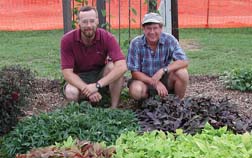 By Kenneth Pecota, Researcher, Department of Horticultural Science, NC State University and Craig Yencho, Associate Professor, NC State University
By Kenneth Pecota, Researcher, Department of Horticultural Science, NC State University and Craig Yencho, Associate Professor, NC State University
Ornamental sweetpotatoes were first noticed in a big way in the mid 1990s with the promotion of the USDA cultivar 'Sulfur', released by Alan Armitage, Ph.D., of the University of Georgia as 'Margarita'. This still popular cultivar is a vigorous, bright lime-yellow plant with heart-shaped to slightly lobed leaves. Its bright color makes it a standout in the landscape and a great color contrast in a mixed planting. Like all ornamental sweetpotatoes, it is a full sun, heat-loving plant grown as an annual. The success of 'Sulfur' helped promote interest in 'Blackie', a purple-green colored, moderately lobed, trailing cultivar. The two were often planted in combination to contrast the colors, but by the middle of the season, the vigorous 'Sulfur' often overwhelmed its lower growing, less vigorous companion. A big, heart- to tooth-leaved, purple-green cultivar known as either 'Ace of Spades' or 'Black Heart' never caught on as well. It too is highly vigorous with a trailing growth habit. 'Pink Frost' or 'Tricolor' is a green/white variegated plant with distinctive pink tips. It's not particularly vigorous and the white areas of the leaves tend to burn in direct sunlight. Nonetheless, it can be a nice accent plant.
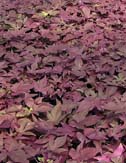 |
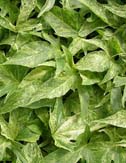 |
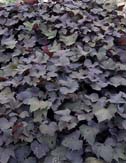 |
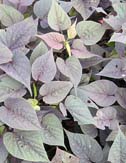 |
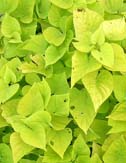 |
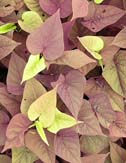 |
During this period, the Sweetpotato Breeding and Genetics Program began to experiment with the color of these cultivars in order to introduce new plant architectures and leaf shapes from table stock clones and plant introductions. Being root breeders, we had no idea what was valuable for the home gardener. Fortunately, we got great input from Bob Lyons, Ph.D., then director of the JCRA, and Brian Whipker, Ph.D., Department of Horticultural Science, NC State University. Sweetpotatoes have a tremendous variability for plant type and leaf shape, and with heavy selection, pressure can be directed towards very aesthetic forms, breaking away from the normally trailing habit. Leaf shapes are equally as varied, not only from cultivar to cultivar, but within a single plant as well! It is not uncommon to find plants that produce heart-shaped to toothed to slightly lobed leaves. Shapes across cultivars range from heart-shaped to toothed to slightly lobed to very deeply lobed, as much as a deeply lobed Japanese maple. Leaf size ranges from less than 3" wide to 8" wide, and is independent of shape.
We had a rather odd goal for a root-breeding program: low yield of storage roots. Ornamental sweetpotatoes will produce sweetpotatoes and have been known to push other plants out of a planter and crack pots. Thus, one of our goals was low-yielding sweetpotatoes! Roots from ornamental sweetpotatoes are edible, but they are rarely nicely shaped and most are not palatable. Flesh colors vary; many have cream-colored roots, but others contain yellow, orange, or purple. In some cases, the flesh is multicolored. Next time you dig one up, slice it open and see.
After developing sweetpotato plants with new combinations of color and plant type, we began to search for companies interested in marketing the material. Bodger Botanicals stepped up to the plate with a marketing strategy not only for what we had, but also for the future. In 2002, we released through Bodger the Sweet Caroline series of ornamental sweetpotatoes as a JCRA Selection. The Sweet Carolines have moderately deeply lobed leaves, good branching, and are relatively compact, making them suitable for planting with each other, while allowing for contrasting color combinations. The original group of four included 'Sweet Caroline Light Green', 'Sweet Caroline Purple', 'Sweet Caroline Green', and 'Sweet Caroline Bronze'. All work well together in mixed plantings or can be used alone. In 2004, we added 'Sweet Caroline Red', with similar plant architecture, but a deep red color that contrasts well with both the light green and bronze colors. In 2005, we added a variegated plant, 'Sweet Caroline Green-yellow'. It has a stable, good contrast green and yellow variegation that shows little burning in the sun. It is not quite as vigorous as the other members in the series, but is a standout in mixed plantings with other species, or by itself.
A one-off followed, 'Sweet Caroline Bewitched', an upright, compact, vigorous plant with purple-green leaves. It has a slight metallic sheen and toothed to maple-shaped leaves. It doesn't fit with the rest of the 'Sweet Caroline series, but is a distinctive entry by itself. It's unusually tall and dense for a sweetpotato, and a nice addition to the group.
Our next group changed directions. The Sweet Caroline Sweetheart series all have small heart-shaped leaves. The plants are well branched and vigorous. The different leaf shape and size is a completely different look from the original Sweet Caroline series. The three members include 'Sweet Caroline Sweetheart Purple', 'Sweet Caroline Sweetheart Light Green' and 'Sweet Caroline Sweetheart Red'. All work well in containers and the landscape. 'Sweet Caroline Sweetheart Red' and 'Sweet Caroline Sweetheart Light Green' also work very well in hanging baskets for their fullness, and for their ability to both climb a little as well as trail over the basket. 'Sweet Caroline Sweetheart Red' has light green tips, which contrast nicely with the color of the mature leaves, giving it a bright character.
All the Sweet Caroline ornamental sweetpotatoes have been patented and bring in revenue to provide support for the development of new and different types. We feel that we have just touched the surface of what is available in colors and plant forms and plan to continue our breeding efforts. As members of the morning glory family, they have attractive tubular shaped flowers ranging from white to lavender in color, which contrast nicely with the foliage. Getting the flowers above the foliage has been a challenge, especially since it depends on how much stress they are grown under. New plant architectures include very compact mounding types suitable for use as annual borders, and climbing varieties capable of forming a light green, purple, or red wall of color. We also continue to expand the color palate available, looking for intermediates, especially in the oranges. Stunning variegated plants can be produced, but tend to be unstable; the search for stability continues. There is a lot of diversity to exploit. Bottom line: expect to see new plants in the future!
Beyond Witchhazel
By Mark Weathington, Assistant Director
 |
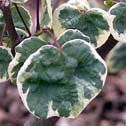 |
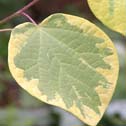 |
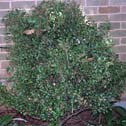 |
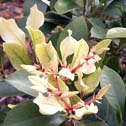 |
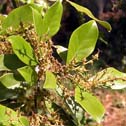 |
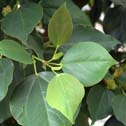 |
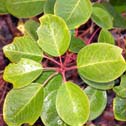 |
Witchhazels have long been an integral part of the landscape with their early spring flowers, great fall color, and few pest and disease problems. These attributes have contributed to the increasing popularity of their relatives in the Hamamalidaceae family. Chinese fringe-flowers (Loropetalum chinense) have become a garden mainstay as fast as any other plant, while the native fothergillas (Fothergilla gardenia and Fothergilla major) with their honey scented bottlebrushes and blazing fall foliage transcend native plant enthusiasts and deserve a place in any garden. Even the winterhazels (Corylopsis spp.) which have long been favorites of the plant cognoscenti, are beginning to make their appearance in a wider variety of nurseries and garden centers. The relatively few pest problems in the family leads to plants that look great all year long, so what other gems are hidden in this low maintenance family?
Disanthus cercidifolius
Hailing from Japan, Disanthus is, as its name implies, a shrubby redbud look-alike. The heart shaped leaves are the main reason for growing this outstanding plant although the reddish purple, witchhazel style flowers in the fall are attractive on close inspection. The foliage emerges in the spring with plum tints, becomes blue-green, and then explodes into red, purple, and orange in the fall. Redbud-hazel is relatively easy to grow in rich, deep soil with at least some protection from afternoon sun. The broad spreading shrub can grow to 12' tall and wide, but can be kept smaller by pruning the older stems to the ground in the winter. The Japanese grow many forms of Disanthus including 'Ena Nishiki', a variegated form with a white edge, and 'Golden Crown', a gold-margined selection.
Distylium racemosum
Even less well known than Disanthus is the genus Distylium, also from Japan. This evergreen shrub known as isu tree is suitable for sun or shade in moist, acidic, well-drained soils. The flowers are generally inconspicuous unless they are searched out in spring, but are an attractive maroon color. The flowers are clustered on 2"-3" inflorescences and reward the close observer. The foliage is simple and dark glossy green, 1"-3" long. In the wild, plants can grow to 50', but under cultivation will rarely top 15'. Several named forms have been introduced including 'Guppy', a dwarf selection, and 'Akobona', whose foliage emerges creamy white before darkening to green. Even rarer in the trade is Distylium myricoides (blue isu), a quicker growing, larger leafed evergreen shrub. In other respects, it is similar to the isu tree.
Exbucklandia populnea
Exbucklandia, recently moved to the Altingiaceae family, is a conversation starter with its large, leathery, glossy, mid-green leaves which create a somewhat tropical feel. The foliage is usually three lobed, often flushed red beneath when young and readily identifiable by the large, conspicuous stipules (leaf-like structures at the base of the leaf stalk). This evergreen tree from the Eastern Himalayas can grow to 60' tall or more, but will usually not exceed 35' in gardens. Easy in most good garden soils, it will take full sun to part shade.
Rhodoleia championii
Another evergreen witchhazel cousin, Rhodoleia forms a small tree with its leaves whorled at the tips of the branches. The thick, leathery leaves are rounded and highlighted by red stems and petioles while the underside of the foliage is pale green. Flowers occur in late winter in drooping clusters. The pink flowers with black anthers are nice against the evergreen backdrop and certainly give the witchhazels a run for the money as showiest in the family. Grow in a warm, protected spot in sun or part shade in an evenly moist soil.
The JCRA's Flowering Agaves and Their Kin
By Tim Alderton, Research Technician
Century Plants
 In the wild, the growth of agaves is limited by the availability of water. As a result, it may take many years for them to reach flowering size, sometimes taking as much as a century to flower. Here in the mesic east, agaves grow much more quickly and attain size much more quickly; as a result, flowering is also accelerated. This past year, we had three species that flowered at the Arboretum.
In the wild, the growth of agaves is limited by the availability of water. As a result, it may take many years for them to reach flowering size, sometimes taking as much as a century to flower. Here in the mesic east, agaves grow much more quickly and attain size much more quickly; as a result, flowering is also accelerated. This past year, we had three species that flowered at the Arboretum.
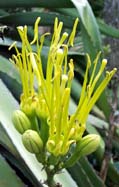 Many noticed the flowering of the Agave salmiana in the Southwestern Garden this past summer. It was the first time that we had seen this widely distributed Mexican species flower in the gardens. The staff and visitors alike watched as the giant asparagus-like spike emerged from the 5' tall and 8' wide octopus-like rosette of long, blue-green, saw-toothed leaves. Over nearly two months, the spike grew to about 20', then finally burst into flower the second week of June. The upward facing, waxy flowers were 3.5"-4.5" long and held in clusters on upturned branches and were adored by bees and wasps. Each flower was made up of a pale yellowish-green ovary and six tepals that together looked like an upside down squid. They were then topped with six long, bright yellow stamens surrounding one pistil.
Many noticed the flowering of the Agave salmiana in the Southwestern Garden this past summer. It was the first time that we had seen this widely distributed Mexican species flower in the gardens. The staff and visitors alike watched as the giant asparagus-like spike emerged from the 5' tall and 8' wide octopus-like rosette of long, blue-green, saw-toothed leaves. Over nearly two months, the spike grew to about 20', then finally burst into flower the second week of June. The upward facing, waxy flowers were 3.5"-4.5" long and held in clusters on upturned branches and were adored by bees and wasps. Each flower was made up of a pale yellowish-green ovary and six tepals that together looked like an upside down squid. They were then topped with six long, bright yellow stamens surrounding one pistil.
For me, this was very fascinating. I had only ever seen large agaves flower once or twice prior to this, and they were in conservatories, not in the open ground. This flowering was strange, though, since even many of the small plantlets that surrounded the mature plant decided to flower as well, just in a scaled down version of 1'-2' tall. These small plantlets gave visitors the opportunity to see the individual flowers without craning their necks, using binoculars, or buying expensive zoom lenses for their cameras. The flowering of the plantlets was unusual because most agaves are monocarpic (flower once, then die after setting seed). Typically, these smaller plantlets would not flower at the same time, and would replace the parent plant after its death, then flower years later. This clone will live on as there is a division planted in the Deal Foundation Garden on the Ruby C. McSwain Education Center's rooftop as well as some rosettes that did not flower.
The other two species of agaves that flowered this past spring and summer were Agave lophantha and Agave striata var. striata.
 The first to flower was Agave lophantha in late May. Agave lophantha has a much smaller habit than that of A. salmiana with foliage that is only up to 1.5' tall and has unbranched flower spikes growing to 10'-15' tall. The flowers of our A. lophantha were composed of one ovary and three sepals, pale green in color and coated in a waxy blue bloom; three pale yellow petals; six long stamens made up of purplish filaments topped in yellow anthers; and a pistil the same purplish color as the filaments. The flat leaves of A. lophantha often have a yellowish streak down the center of the green leaves which are edged in teeth. The individual flowers were arranged around the unbranched stalk in small groups of up to five florets.
The first to flower was Agave lophantha in late May. Agave lophantha has a much smaller habit than that of A. salmiana with foliage that is only up to 1.5' tall and has unbranched flower spikes growing to 10'-15' tall. The flowers of our A. lophantha were composed of one ovary and three sepals, pale green in color and coated in a waxy blue bloom; three pale yellow petals; six long stamens made up of purplish filaments topped in yellow anthers; and a pistil the same purplish color as the filaments. The flat leaves of A. lophantha often have a yellowish streak down the center of the green leaves which are edged in teeth. The individual flowers were arranged around the unbranched stalk in small groups of up to five florets.
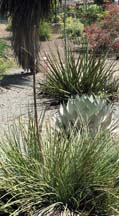 The
second was Agave striata var. striata. This species looks
very different from both A. salmiana and A. lophantha with
its long needle-like leaves. Most would not recognize it as being a relative
because of the long thin leaves that appear unserrated. But if one carefully
dodges the needle like spine tip of the leaves and feels the leaf edges, they'll
notice that there are minute teeth just like the large very apparent teeth
seen on most, though not all agaves. Agave striata var. striata flowered
throughout most of July with individual flowers lining unbranched stems that
grew 8'-10' tall. The flowers of A. striata var. striata were
smaller than those of both the A. salmiana and A. lophantha,
measuring only about 1.5"-2" from the base of the ovary to the tips
of the stamens. Flowers were colored pale creamy green with a hint of purple
on the stamen.
The
second was Agave striata var. striata. This species looks
very different from both A. salmiana and A. lophantha with
its long needle-like leaves. Most would not recognize it as being a relative
because of the long thin leaves that appear unserrated. But if one carefully
dodges the needle like spine tip of the leaves and feels the leaf edges, they'll
notice that there are minute teeth just like the large very apparent teeth
seen on most, though not all agaves. Agave striata var. striata flowered
throughout most of July with individual flowers lining unbranched stems that
grew 8'-10' tall. The flowers of A. striata var. striata were
smaller than those of both the A. salmiana and A. lophantha,
measuring only about 1.5"-2" from the base of the ovary to the tips
of the stamens. Flowers were colored pale creamy green with a hint of purple
on the stamen.
Agave Cousins
If you missed these three agaves in flower, you may have to wait a few more years to see them again, but some of their cousins are not as shy about flowering. Each year in the garden, you will see several other genera from the agave family, Agavaceae. There are numerous species of Yucca throughout the garden that are graced with creamy white spikes each year. You may also recognize the Hesperaloe: H. campanulata, H. funifera, and H. parviflora, flowering for much of the summer with flowers of creamy pink or greenish white.
Two of the closest relatives to the agaves are the Manfreda, and the Polianthes which are sometimes lumped into the genus Agave. Both of these are deciduous and die to the ground each year. Manfreda species are known for their often spotted foliage and occasional spidery flowers. The Polianthes are better known as the tuberoses. Best known for the fragrant, white flowers of Polianthes tuberosa, there are also creamy pink, yellow, and orange shades found in the flowers of other species and hybrids. You may have noticed P. 'Chirp' and P. 'Sunset' in the garden around the Necessary, both having unscented flowers of creamy pink to orange.
All of these Agave relatives are at home in the sunniest spots in the yard, but one of the latest genera to join the Agavaceae will surprise most and is present in most shade gardens not plagued by voles. This shade tolerant Agave relative is none other than Hosta. If you look at their flowers and compare them to the Agave, Yucca, Hesperaloe, Manfreda, and Polianthes, you may see the similarities. Who would have thought! A couple of other genera to add to the list are Chlorophytum (spider plant) and Beschorneria (false red agave).
In the next few years, we look forward to the flowering of other species of Agave with their often large and spectacular inflorescence. Keep an eye out for the agaves and their kin in the garden when you visit.
Fragrant Plants for North Carolina Gardens
Denny Werner, Ph.D., Director, JCRA
All too often, gardeners tend to focus only on floral attributes when choosing plants for their landscape, many times overlooking the virtues of characters such as fragrance, texture, movement, and form. In large part, we are still a society that buys with our eyes, and many consumers like the instant gratification of buying a plant in full flower, taking it home to instantly enhance the landscape. This is understandable, but those of us who take gardening more seriously like to look beyond flowers and color, and select plants that stimulate all of the senses, particularly our sense of smell. Fragrant plants add a whole new dimension to the garden, and particularly enhance the character and enjoyment of the garden in the evening and nighttime hours. Plants and gardening evoke many memories, some unpleasant, like an unanticipated encounter with poison ivy or stinging nettle, but most are pleasant and satisfying, such as the memory of a dear departed gardening friend who shared a plant with you many years ago, and whose memory lives on in your garden through that plant. A specific fragrance often evokes a distinct event or recollection. In fact, research on human behavior has shown that our sense of smell is the sense most strongly associated with memory. Information from our olfactory system is partly processed in parts of the brain that control memory, emotion, and behavior (see http://www.apa.org/monitor/jan98/smell.html). I have always included many fragrant plants in my home garden, and the JCRA collections include scores of fragrant herbaceous and woody plants.
Plants have the ability to synthesize an incredibly diverse number of secondary biochemical compounds, including some that are fragrant. Such compounds are involved directly or indirectly in a variety of roles, including pollinator attraction, predator and pest resistance, disease response, seed dispersal, stress response, pigmentation, etc. Many of these chemicals have medicinal properties, and have been used by man for that purpose. For example, salicylic acid plays an important role in the plants' response to pathogen infection. Man uses this compound medicinally for a number of purposes, and markets it as aspirin. Digitalin, synthesized by members of the genus Digitalis, is widely used as a heart medication. The function of many plant biochemicals still remains unknown.
There are so many great choices of fragrant plants, and in this short article, I will discuss the characteristics of some favorites that have brought me so much satisfaction. I have always been taken with the large Abelia chinensis that resides in the far reaches of the west Arboretum. This medium to large, multi-stemmed deciduous shrub, easily grown in moderately dry to moist sites, graces the late summer to early fall garden with an abundance of large, fragrant inflorescences on the terminal ends of new shoots. Since it flowers on new growth, it can be pruned back significantly in the dormant season to control height. Tiger swallowtail butterflies seem to be particularly attracted to this plant. J. C. Raulston, Ph.D., often used to refer to it as a "butterfly magnet." A. chinensis is found in the parentage of many of the common interspecific hybrid abelia cultivars in the trade, but, unfortunately, most of the hybrids lack the fragrance of A. chinensis, typical of many hybrid combinations between fragrant and non-fragrant parents. This is one plant I wouldn't be without in my home landscape. This plant is rarely available in garden centers, so search it out on the Internet to find a source. It grows rapidly, so don't be reluctant to acquire a small plant.
Buddleja, the common butterfly-bush, has come under increasing scrutiny in the past few years because of concerns about its invasive potential in Europe and some parts of the United States. In the future, look for the availability of cultivars that set fewer seed or that are totally seed sterile, both under development in breeding programs at this time. Buddleja is one of the best plants for attracting butterflies into the garden, is easy to grow, flowers a long time, and most cultivars emit a delightful fragrance. So many cultivars are available that it would take a book to describe them all, but some of my favorites are 'Lochinch' (light purple), 'Pink Delight' (deep pink), 'Attraction' (red-purple), and 'Ellen's Blue'. Here at the JCRA, we are preparing to release new cultivars showing improved flower color, semi-compact growth habit, and reduced seed setting potential. Look for these to be commercially available in 2008 and 2009.
Clethra alnifolia, our native summersweet, is a beautiful, medium-sized, deciduous shrub producing an abundance of mostly terminal and occasionally subterminal panicles. Flowering occurs in mid to late July, extending well into August. This species is a great choice for moist to wet sites, and will not tolerate extended periods of drought. Summersweet produces a strong, spicy fragrance that never fails to attract numerous insects. Three cultivars are predominant in the trade. 'Hummingbird' is a popular choice, possessing white flowers on a compact plant. Although it shows a tendency to sprawl as it ages, it still is a star performer in my home landscape. 'Sixteen Candles' is a semi-compact form developed by Mike Dirr, Ph.D., and shows a more upright, stiff growth habit, compared to 'Hummingbird'. My favorite choice is 'Ruby Spice', the beautiful pink-flowered form. 'Ruby Spice' can attain heights of 6'-7', and like all Clethra, can spread slowly via underground rhizomes and form small colonies. 'Ruby Spice' was discovered as a bud sport (limb mutation) on 'Pink Spires', a light pink cultivar. Some years ago, I conducted some breeding work in Clethra, crossing 'Ruby Spice' and 'Hummingbird', with the objective of combining deep pink flower color and compact growth habit. The first generation plants showed the vigor of 'Ruby Spice', and produced flowers showing only a slight pink blush, much lighter than 'Ruby Spice'. The F1's were intermated to obtain F2 progeny. Considerable variation in plant height was observed in the F2, but in a population of hundreds of plants, we were unable to recover any progeny demonstrating flower color even approaching the intensity of 'Ruby Spice'. These results suggest that 'Ruby Spice' is a chimera, and that the genes responsible for the intense pink pigmentation in 'Ruby Spice' are not present in the cell layer responsible for forming the sex cells. Hence, the deep pink flower color, although expressed in 'Ruby Spice', is not transmitted to its offspring.
Osmanthus fragrans, the fragrant tea olive, is one of the best shrubs for fall and winter flowers and fragrance. Osmanthus fragrans is an evergreen large shrub or small tree, typically hardy only to Zone 7. The fragrance is quite remarkable, and when one walks the garden in fall, one usually detects the fragrance before seeing the plant. Any of the cultivars will bring pleasure, but 'Fudingzhu' offers the most impressive floral display, extended flower time, and incredible fragrance.
The Easter weekend freeze eliminated the floral display on one of my favorite spring flowering trees, Chionanthus virginicus, the fringetree. The 18-year-old specimen in my home landscape is displaying the character that only comes with age, and in the JCRA, an older specimen of its Asian relative, Chionanthus retusus, is a favorite of visitors when in full flower. I have observed Chionanthus in flower for many years, but only in 2006, when I had the opportunity to visit a garden and walk in close proximity to numerous specimens in flower, did I appreciate the soft, delicate fragrance produced by both of these species. It is certainly not a strong and pervasive fragrance, but an alluring one, a subtle fragrance that invites one to get closer to the plant to appreciate its true character. Both species are widely adaptable and very cold hardy, particularly C. virginicus. Availability of both species is limited, as propagation is challenging.
The overwhelming number of Hemerocallis (daylily) species and cultivars available in the trade can make specific choices difficult, but if one restricts one's self to those possessing fragrance, the choices become more limited. Admittedly, I am not a student of the daylily, and have limited knowledge of the breadth of cultivar choices demonstrating fragrance. In the species types, choose the yellow-flowered H. flava (lemon lily) or H. citrina (citron daylily),or choose hybrids possessing either species in their background. One of the first hybrids, an Elizabeth Lawrence favorite, still popular since its introduction in the 1920s, 'Hyperion' has stood the test of time. Demonstrating a soft yellow flower color and the classic, simple daylily flower form so often missing in the modern hybrids, 'Hyperion' contributes much to the fragrant garden. An alternative to 'Hyperion' is 'Tetrina's Daughter', showing a slightly deeper yellow flower color, and taller flower stalks. Many fragrant daylilies, including the species and cultivars discussed above, demonstrate nocturnal flowering behavior. Unlike most daylily cultivars whose flowers open early in the morning and perish in early to late afternoon (diurnal flowering behavior), the flowers of nocturnal cultivars open in late afternoon to early evening, stay open all night, and perish the following morning. Those who work an eight-to-five job rarely have the opportunity to enjoy the flowers on standard diurnal cultivars, as they have perished prior to one's arrival home from work. Nocturnal cultivars can be appreciated in the evening and nighttime hours.
A close relative of the agave, the hosta, has little to offer in fragrance, except for one species, Hosta plantaginea, and hybrids derived from it. H. plantaginea, often referred to as autumn lily, produces spikes of fragrant, white flowers in late summer. This species is widely adapted, demonstrates excellent tolerance to heat, and is available in single- and double-flowered forms. I have fond memories of this plant from my youth in Pennsylvania, as my grandmother always nurtured a patch of autumn lily near the back door of her house. When I catch the fragrance of autumn lily, I'm taken back to those warm summer evenings, sitting on the back porch with my grandparents, listening to my grandfather tell fishing stories about that catfish that got away, eating ice cream, and watching the lightning bugs dance in the night air. Life was good (and still is!).
In most of my presentations to various nursery and gardening groups, I always take the opportunity to promote greater usage of crinum lilies (Crinum) in southern gardens. Their abundant foliage and beautiful flowers add both a textural and color element to the border, and the subtle fragrance is an added bonus for fanciers of this group of plants. An individual crinum will often outlast the gardener who planted it and the architecture that it is planted around. Long lived, drought tolerant, and adaptable to a wide range of soil types, crinums bring so much pleasure for so little investment. Like most members of the family Amaryllidaceae, crinums are rarely injured by voles. Numerous cultivars are available; four that have proven their mettle in many gardens are 'J.C. Harvey' (light pink), 'Ellen Bosanquet' (deep pink), 'Ollene' (white) and 'Cecil Houdyshel' (medium pink). Clearly, assigning names to cultivars of Crinum has been a low budget endeavor with no involvement of high-priced marketing consultants! However, despite the pedestrian names, these are great plants, and deserve a place in the low maintenance garden. They also make great cut flowers.
I have been challenged to stay abreast of the avalanche of new summer phlox (Phlox paniculata) cultivars that have been introduced in the trade in the recent past, so much so that I have decided to continue with the tried and true cultivars I have grown for many years, and let others sort the good from the bad among the new arrivals. Phlox paniculata is one of the mainstays of the summer border, and choosing cultivars resistant to powdery mildew results in flowers from early summer through fall. Their fragrance is subtle but distinct, not overwhelming. I have grown the white-flowered 'David' for many years in my home garden, and judge this to be a superior plant for powdery mildew resistance, stature, long-term flowering, and fragrance. I had the distinct pleasure of meeting the discoverer of 'David' phlox, F. M. Mooberry, at a gardening event in 2006. She named 'David' in honor of her husband. I find it interesting that plant breeders have strived for many years to breed mildew resistant phlox, yet 'David', the benchmark against which all others are judged, was found as a chance seedling growing in a bed of phlox at the Brandywine River Museum in southeastern Pennsylvania. Mmmm, maybe plant breeders are over-rated, but being one, perhaps I should retract that statement. 'Robert Poore', lavender with a white eye, is another tried and true mildew resistant cultivar, and if you need a third mildew resistant choice, it's hard to beat the old southern pass-along cultivar 'Delta Snow', showing a white flower with a purple eye.
Another personal "memory" plant that I always accommodate in my garden is Mirabilis jalapa, the four o'clock. This old pass-along plant is a native of South America, and has graced southern gardens for centuries. This plant was always a staple in my mother's garden, and its sweet evening scent is unrivaled. Usually opening between 6:00 PM and 7:00 PM in my Raleigh garden, the sweetly scented flowers perfume the evening air for a considerable distance. It is available in a variety of standard colors including red, yellow, white, and purple, but I especially enjoy growing the variegated flower forms. Available in the trade as 'Broken Colors' and 'Kaleidoscope', these variegated cultivars produce beautiful flowers with an amazing combination of colors and patterns on the same plant. In my garden, I have found the variegated forms to be less vigorous, only marginally cold-hardy in Zone 7, and likely to produce less seed. The latter character is an attribute, as one of the liabilities of four o'clock is their tendency to self sow to the point of aggravation in the garden. Four o'clock forms very large underground tubers which in colder climates can be dug at the end of the season and stored in a cool location for overwintering. Another great attribute of this plant is its attractiveness to night flying moths, such as the sphinx and hawk moth. It's great to go out into the garden at dusk, and watch these graceful insects flit from flower to flower in search of nectar. Children especially like to watch these graceful insects at work in the evening garden.
No discussion of fragrant plants would be complete without inclusion of a member of the genus Oenothera, which includes the evening primroses. My personal favorite in this group is the "magic" evening primrose, Oenothera lamarkiana. This biennial is undoubtedly one of the best plants to grow to capture the interest and wonder of a child. Around dusk on hot summer nights, the large yellow flower buds first begin to quiver, followed by rapid separation of the sepals, and finally terminating in the unfurling of the petals. The entire time frame from completely closed to open flower is about 5-10 seconds. After opening, the most remarkable spicy fragrance permeates the air, and shortly thereafter, the sphinx and hawk moths move in for an early evening nectar treat. I have wonderful memories of growing this plant in my prior residence in Raleigh many years ago. My children were very young, and the neighborhood was comprised of many families with young children. The neighborhood kids discovered this great plant in my garden, and every evening, a group of children would race down the street around dusk to watch the magic plant. I like to think that these special moments experienced by these children with this special plant may in some way have had a positive impact on their life, or sparked in them a love and respect for the natural world. Every encounter helps.
So many wonderful fragrant plants are available to the gardener. Consider fragrance the next time you are choosing plants for your garden, and create some special life-long memories for you and your loved ones.
Development
Developing News
By Autumn Keck, Associate Director of Membership and Fund-raising Events
An Opportunity for Even More Plants
It's Connoisseur Plants time again and this year there is a great opportunity to get even more plants than last year. With the addition of our new Founder membership level, all members who participate at the $1,000.00 level get eight Connoisseur Plants. This is the first year we are making this level available for our members.
In case this is your first year as a Friend of the Arboretum, here is a quick synopsis of our Connoisseur Plants program. Each year as a special benefit for our Sponsor, Patron, Founder, Benefactor, and Philanthropist members, we offer plants that are either rare or hard to find old favorites. In the early fall, all members receive a letter that gives them the opportunity to increase their membership to become eligible for this program or upgrade to get more of the wonderful plants. Next, all the eligible members will receive a catalog of plants to choose in early December. The catalog will give exact instructions on how to choose your plants, the number of plants that you will receive, and a description of each plant. Finally in early spring, eligible members will be contacted and invited to pick up their plants or have them shipped directly to their home.
If you are interested in this program or would like more information, feel free to contact Autumn Keck at autumn_keck@ncsu.edu or (919) 513-3826.
We are Bringing the Friends of the Arboretum Lectures to You
Have you ever heard about an interesting speaker at a Friends of the Arboretum Lecture that you were unable to attend? Do you live so far away that you will never reap the membership benefit of the FOA Lectures?
With our members being spread throughout the state of North Carolina and beyond, we want to keep everybody connected to the excellent educational opportunities that are offered at the JCRA. Now, no matter where you reside, you will be able to see the Friends of the Arboretum Lectures from the comfort of your own home. We are posting all of our taped FOA Lectures on the Arboretum Web site with a special password for members only. You'll need to know the password. It's printed to the right of this paragraph on your address label.
Please visit our Web site for more information about how you can enjoy the FOA Lectures from your own home.
2007-2008 Benefit Providers
The following is a list of this year's benefit partners:
F. A. Bartlett Tree Expert Company
Better Tree Care Associates
Big Bloomers
Campbell Road Nursery
Down to Earth Designs
Fairview Greenhouse and Garden Center
GardensGardens
The Garden Hut
Garden Supply Company
Homewood Nursery and Garden Center
Hoyt Bangs Landscape Design Services
Indigo Marsh Nursery
Lasting Impressions
The Last Unicorn
Long Hill Bed and Breakfast
McDonald's Nursery
Mountain View Nursery
Nature's Select Premium Turf Services
Neomonde Deli
Night Magic Lighting
Norwood Road Garden
Oakmont Nursery
Outdoor Images
Ragazzi's (Cary)
Sarah P. Duke Gardens
Secret Gardens
Smith and Hawken (Crabtree Valley Mall)
Summer Classics Garden Furniture
Wakefield Nursery and Landscaping
Willow Tree Landscaping
www.wsiselectwebsolutions.com
Refer to our Web site at https://www.ncsu.edu/jcraulstonarboretum/ for a list of their discounts and contact information. Discounts are valid through September 2008, when another list will be issued.
Volunteering
Volunteer News
By Barbara Kennedy, Volunteer Coordinator
As your new volunteer coordinator, I am delighted to be working with the dedicated volunteers and staff at the Arboretum. As a longtime volunteer, I got to learn so much from working in the gardens and with the people that make it run. Now I look forward to assisting volunteers with their needs and making sure our many activities have the support needed.
I joined the staff at a busy time. September and October have been chock full of events. Our volunteers have been terrific at filling the many roles we have asked them to fill. Here is a sampling of how the volunteers have contributed:
- Watering plants at 6:00 AM and 6:00 PM on Tuesdays
- Checking guests into our FOA Lecture series
- Preparing plants for the FOA Annual Plant Distribution
- Help at the Garden Conservancy's Open Garden Days and at Celebrate North Carolina Wines
- Stuffing and mailing envelopes with invitations or information
- Welcoming guests to Arborfest
If you would like to be part of this exciting group, we are currently looking for tour guides, labeling and mapping of plants volunteers, and Visitor Center staff.
Formatted into HTML by Christopher
Todd Glenn
Programs and Education Coordinator
JC Raulston Arboretum
Department of Horticultural Science
North Carolina State University
Raleigh, NC 27695-7522
© The JC Raulston Arboretum, November 2007

